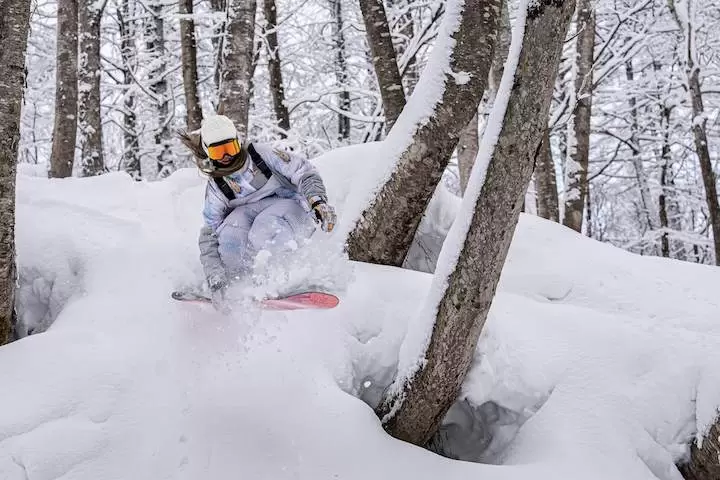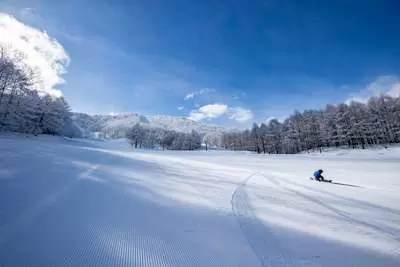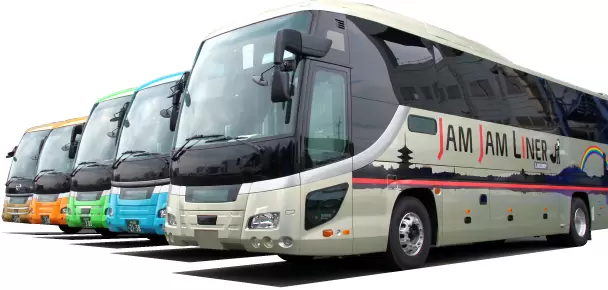Let's go on a tree run in Japan! A complete guide to the attractions and safe ski resorts

Tree running, a dynamic slide through untouched nature, is now attracting attention from both within Japan and overseas as a thrilling and easy activity in an age when gondolas and lifts can be used to access snowy mountains. Here we will introduce the appeal of tree running in Japan.
What is a tree run?
Tree runs are a style of skiing and snowboarding that take advantage of the natural terrain in ungroomed areas.
Unlike groomed courses, you must avoid natural obstacles such as trees and rocks as you ski.
The tree runs, which make use of the natural terrain, allow you to experience the essence of the snow-capped mountains and are popular with thrill-seekers and snowboarders.
Difference between tree running and backcountry
"Tree run" and "backcountry" basically have the same meaning, but there are some subtle differences.
"Tree runs" are found within ski resorts or managed areas, and are a style of skiing that mainly involves skiing between trees or in ungroomed areas that make use of the natural terrain.
On the other hand, backcountry generally refers to wild skiing and snowboarding in an environment close to nature, outside of managed areas such as ski resorts.
Another feature of backcountry skiing is that you climb the mountain on your own without using a lift and ski down the natural terrain.
The reason behind the popularity of tree running
There are many factors behind the popularity of tree running.
First of all, advances in equipment have made it easier to enjoy riding on fresh snow than before, and so skiing styles have become more diverse.
And for ski and snowboard fans seeking thrills and adventure, the appeal of skiing through the beautiful forests of Japan's natural beauty seems immeasurable.
In addition, ski resorts are actively working to accommodate tree runs by opening up tree runs and expanding areas, and as a result, tree runs can now be enjoyed at many ski resorts across Japan.
The appeal of tree running in Japan

Skating in the great outdoors of Japan is more than just a sport; you'll feel as if you are in dialogue with nature.
Here we will take a deeper look into the appeal of tree running in Japan.
1. Powder snow is gathering
The biggest attraction of tree running in Japan is the abundant powder snow that accumulates after snowfall.
The ungroomed areas are literally not groomed, so there is plenty of powder snow remaining in the forest.
The deep, packed snow is protected from wind and sunlight by the lush trees, helping to keep the powdery condition last longer.
That's why, when tree running in Japan, you can enjoy skiing on powder everywhere.
By the way, Japan's powder snow is also called "japow" and attracts ski and snowboard fans from all over the world.
2. The ski resort has a perfect environment for tree running
As if responding to the recent tree running boom, there is a movement at Japanese ski resorts to open up the forests on their slopes as tree running courses.
Additionally, ski resorts are now offering shorter, gentler courses with fewer trees on tree-running courses that were previously only available to advanced skiers. With the improved environment and lowered barrier to entry, even beginners can try tree-running with confidence.
3. Enjoy Japan's unique terrain
Another great thing about tree running in Japan is that you can enjoy the unique mountain scenery.
With a unique landscape formed by thousands of years of volcanic activity, it is known as one of the world's top winter sports destinations.
The diverse natural elements of Japan's terrain, such as gliding through quiet forests and circling around poplar and birch trees, are sure to tickle the playful side of tree-climbing enthusiasts.
Furthermore, since the terrain and environment vary greatly from place to place in Japan's mountains, you can experience different tree runs in each location.
4. Breathtaking natural beauty of snow and wildlife
Japan's snow-covered landscapes are incredibly beautiful and the wildlife you'll encounter while tree running adds to the magical atmosphere.
You can often spot monkeys roaming near the calm, snow-covered streams and at the bottom of the valleys.
Furthermore, in the forests of central Honshu, you may have a chance to encounter the Japanese serow, which was designated a special natural monument by the Japanese government in 1955.
The dangers of tree running
Tree running also carries the following risks:
- Risk of avalanche
- Risk of slipping or falling from cliffs, steep slopes, or snow cornices
- There is a risk of falling from the area where snow covers the top of a deep stream.
- Risk of losing route due to sudden deterioration of weather
- Risk of getting lost due to poor route selection
- There is a risk of skiing down a route that would be impossible to return to other than climbing the ski slope.
Whether you're a beginner or an advanced climber, you can safely enjoy tree running in Japan by considering all possible dangers.
How to enjoy tree running safely in Japan
To enjoy tree running safely in Japan, there are many rules that must be followed.
Here we will explain in detail the preparations and measures you can take in advance, as well as the safety precautions you should take on the day.
Know that there are basic rules and local rules
You must understand and follow the basic and local rules set by each ski resort.
Some ski resorts will revoke your lift ticket if you break the rules.
As a main basic rule, many ski resorts require you to submit a "mountain climbing notification" or "mountain entry notification" that details your exact route before tree running.
The reason for filling out the "Mountain Climbing Notification" and "Mountain Entry Notification" is to facilitate rapid search and rescue. The "Mountain Climbing Notification" and "Mountain Entry Notification" are available at the office of each ski resort or online.
Depending on the region or ski resort, there may be local rules for using the tree run area, such as the following:
[An example of a ski resort's unique rules for tree runs]
- Participate in advance training
- Sign the pledge
- Wearing armbands and bibs
- Wear a helmet and protective gear
- Mobile phone carrying
Find out as much as possible about the ski resort's specific rules before you travel, and make appropriate preparations and take appropriate measures.
Learn about "Self-Responsibility Areas"
"Self-responsibility area" refers to the ski areas on snowy mountains beyond the ski resort's managed area.
Basically, there is no safety management by the ski resort in the "Self-Responsibility Area." Therefore, any risk of getting lost or having an accident in the "Self-Responsibility Area" is the sole responsibility of the skier.
You must understand that in the event of a disaster or accident, all search and rescue costs will be borne by you.
Please enjoy tree running responsibly to avoid getting lost or having an accident.
Check the weather
The quality of snow in the area not only varies greatly depending on the season and weather, but can also change at any time throughout the day.
Therefore, it is necessary to accurately understand the conditions, taking into account the local season and weather.
It is especially important to be extremely careful on cloudy days or when it is snowing heavily, as visibility can be poor in the forest.
Before going skiing, be sure to thoroughly check the weather on the mountain and the latest forecast for the day, and predict the route conditions and snow instability and trends before attempting a tree run.
Understand the terrain and geography of the area where you plan to tree run.
On the day of your tree run, always be aware of where you are in the mountains and be careful not to stray too far from the well-maintained tree run course.
To familiarize yourself with the terrain and geography of a particular ski area in advance, follow these steps:
[Examples of ways to understand Japan's topography and geography in advance]
- Hire a guide
- Get someone with local knowledge to accompany you
- Search on the Internet
It is also important that all group members understand and memorize the planned tree run route.
Check the level of your companions
If the tree run route planned in advance does not match the physical strength and skill of all participants, safety may be compromised. Since this is a tree run in a foreign land, be sure to communicate closely with the people who are going with you.
Gear up
When attempting tree runs, always be sure to wear a helmet. Most ski resorts recommend the following equipment in case of an emergency:
[Recommended equipment to bring]
- Avalanche Beacon
- probe
- shovel
- water
- food
- Additional clothing
- First aid kit
- writer
- Headlamp
Don't overestimate your skills
In order to avoid danger, careful action and calm judgment are also essential. Unexpected dangers lurk in tree runs. In addition to skiing carefully, you need the ability to ski flexibly while avoiding danger when necessary.
Taking an avalanche safety course or tree run preparatory training can be an opportunity to objectively evaluate your skills. If you feel that your skills are lacking even a little, carefully consider whether or not to try tree running.
Share information with family members
In particular, when planning tree runs or mountain climbing outside the ski resort's managed areas, it is important to share information not only with other participants but also with your family members waiting for you to return home, so that they are on the same page. Be sure to check and share your tree run plans in Japan with all of your skiing friends, as well as your precious family members, and make sure they understand them.
If you have any questions, please feel free to check on-site.
If you have any questions about tree running in your area, don't hesitate to ask local staff or patrols. Some areas, such as Nozawa Onsen, provide additional information in English about sidecountry and backcountry areas.
Areas in Japan where you can enjoy tree running

The main areas in Japan where you can enjoy tree running are as follows:
- Hokkaido
- Iwate Prefecture
- Nagano Prefecture
- Niigata Prefecture
- Gunma Prefecture
- Gifu Prefecture
We will introduce in detail the characteristics of tree runs in each region and the ski resorts that are worth visiting.
Hokkaido
Hokkaido can be said to be a paradise for tree orchid lovers.
The following areas in particular are world famous:
- Niseko
- Rusutsu
- Furano
Niseko is easily accessible from Sapporo and is located near Mount Yotei, also known as "Hokkaido's Mount Fuji."
However, depending on your departure point, you may need to transfer to a domestic flight at an international airport such as Narita or Haneda. There are direct flights from Asia and the Pacific to Sapporo, but only flights to Helsinki from Europe, so depending on your departure point, the cost may be significantly higher. (As of November 2023)
Iwate Prefecture
Iwate Prefecture is known as a hidden gem for tree running due to its geographical location, and the Appi Plateau and Geto Plateau are famous. The characteristics of each are as follows.
- Appi Kogen: A ski resort on a scale comparable to that of Europe, with six of the best areas in Tohoku for tree running
- Geto Plateau: Famous for the powder snow that falls in this heavy snow area. The tree run on the slopes is particularly noteworthy.
The most common way to get to the ski resorts listed above is by Shinkansen and bus, or by car, but if you are not familiar with Japan's transportation system, it may be difficult to access the ski resorts.
Nagano Prefecture
Nagano Prefecture, home to the 1998 Olympics, is the region with the most ski resorts in Japan. Located inland and with high mountainous altitudes, many of the ski resorts in Nagano offer japow (Japanese powder snow) and tree runs.
Although it may seem difficult to get to because it is located inland, Nagano Prefecture is actually surprisingly easy to access. In particular, you can get there by taking the "Snow Liner" express bus, which goes directly from Narita Airport, Haneda Airport, and Tokyo to the Hakuba area, or by transferring to the Shinkansen and local buses.
Niigata Prefecture
Niigata Prefecture also has many ski resorts where you can enjoy tree running, as shown below.
- Kagura Ski Resort features a highly challenging tree run course
- "Kandatsu Snow Resort" with its abundant snowfall
- Lotte Arai Resort boasts one of the largest snowfalls in Japan
- Yuzawa Nakazato Snow Resort: A hidden gem with deep snow and challenging courses
The most convenient way to get to Niigata Prefecture is by using the direct ski resort buses for Japanese people, but you can also travel by Shinkansen or car.
In addition, Niigata Prefecture borders Nagano Prefecture, so it would be a good idea to travel back and forth between the ski resorts in both prefectures.
Gunma Prefecture
Gunma Prefecture, close to Tokyo, also has several ski resorts where you can do tree running.
- Manza Onsen Ski Resort: Enjoy a forest course at the summit
- Marunuma Kogen Ski Resort: The entire ski resort is covered in powder snow
The main ways to access the ski resorts listed above are by train and bus, or by car.
Therefore, it is suitable for people who are familiar with Japan.
Gifu Prefecture
Gifu Prefecture's ski resorts are hidden gems for tree running.
- Takasu Snow Park Dynaland has five tree run courses for beginners to advanced skiers.
- Biwako Valley Ski Resort: Enjoy powder snow riding on forest trails with excellent snow quality
The main ways to get to the area are direct buses from Nagoya or Osaka (for Japanese people), as well as cars, JR transfers, and local buses.
As can be seen from the above, this is aimed at people who are familiar with Japan.
If you're looking for tree running, we recommend the Nagano area, which can be reached by direct bus.

If you want to enjoy tree running, we recommend the Nagano area, which can be reached by the direct bus "Snow Liner."
"Snowliner" is an express bus that goes directly to ski resorts and is provided by Nippon Youth Travel, the company that operates this media site "MATCHA".
You can travel directly from major international airports such as Narita and Haneda, as well as from Tokyo, to the many ski resorts in Nagano Prefecture that have tree runs.
Reservations can be made easily through the English-language website, making it convenient for ski and snowboard enthusiasts from overseas.
If you want hassle-free access to ski resorts in Nagano Prefecture, be sure to check out Snow Liner via the link below.
Enjoy tree running in Japan this winter!
In this article, we have introduced in detail the appeal of tree running in various parts of Japan and how to enjoy it safely.
In the past, it was common to bring skis with you when climbing snowy mountains and enjoy skiing in the natural surroundings of the mountains.
However, nowadays, access to snowy mountains has become easier, and ski resorts where you can easily enjoy tree running are gaining popularity.
To ensure a safe ski and snowboard trip, be sure to follow the tips introduced here and enjoy tree running to your heart's content in Japan's beautiful nature.
We operate direct buses from Haneda/Narita Airport to each ski resort. https://spur.jamjamliner.jp/
The contents on this page may partially contain automatic translation.

































![[2026] Top 5 Strawberry Picking Spots in Tokushima, Naruto| Farms and Access Guide for January to May](https://resources.matcha-jp.com/resize/720x2000/2025/03/06-227165.webp)



